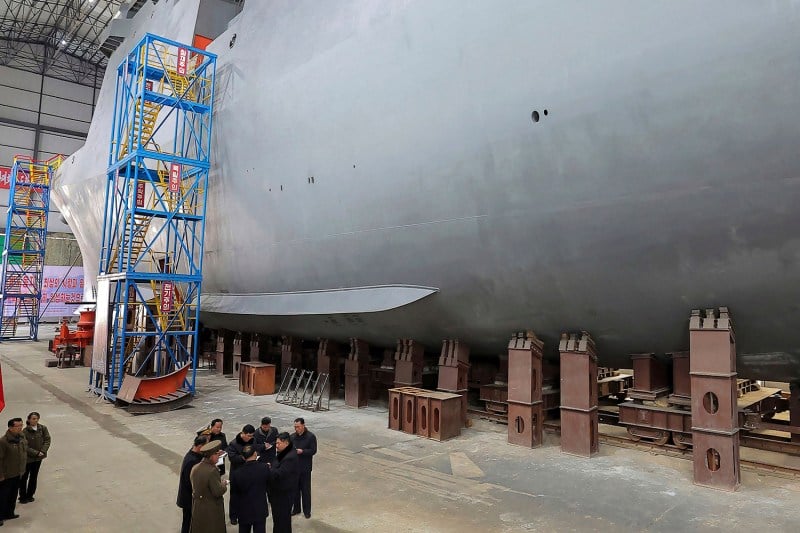North Korea’s Nuclear Submarine May Not Be as Scary as It Looks

North Korea’s Nuclear Submarine May Not Be as Scary as It Looks
Pyongyang says it is building a “strategic guided missile” submarine, but experts say the development may not be all it’s cracked up to be.
North Korean leader Kim Jong Un visits a shipyard in an undated photo provided on March 8 by the North Korean government. Korean Central News Agency/Korea News Service via AP
Amazingly, North Korea’s apparent unveiling of a nuclear-powered submarine last week has garnered relatively little notice—understandable given the pace of the current news cycle.
South Korean intelligence had already flagged last fall the possibility that Pyongyang was seeking a nuclear-powered addition to its already sizeable undersea flotilla, and North Korea has been talking up the prospect for years. But last week’s visit by North Korean leader Kim Jong Un to what’s supposedly a nuclear-powered boomer under construction is what set some alarm bells ringing around the region and in Washington.
Amazingly, North Korea’s apparent unveiling of a nuclear-powered submarine last week has garnered relatively little notice—understandable given the pace of the current news cycle.
South Korean intelligence had already flagged last fall the possibility that Pyongyang was seeking a nuclear-powered addition to its already sizeable undersea flotilla, and North Korea has been talking up the prospect for years. But last week’s visit by North Korean leader Kim Jong Un to what’s supposedly a nuclear-powered boomer under construction is what set some alarm bells ringing around the region and in Washington.
North Korean media described the vessel as a “strategic guided missile” submarine, which would at least fit with the Hermit Kingdom’s multiyear quest to develop and perfect submarine-launched missiles (including cruise missiles) and decades-long journey to become a recognized and credible nuclear power. Pyongyang just got its latest modernized diesel-electric submarine, the first one capable of actually carrying and launching its subsea missiles, out of drydock.
If the reports are true, there could be several potential troubling implications.
First, North Korea’s military assistance to Russia for its war in Ukraine, including the dispatch of at least 10,000 troops last year, as well as trainloads of artillery shells and rockets, may possibly be paying big dividends in terms of the transfer of extremely high-end Russian military technology. Though experts cannot track the transfer of Russian blueprints as easily as they can North Korean troops, they say it is extremely unlikely that Pyongyang could successfully construct a nuclear-powered submarine without technical assistance. (That said, the timeline doesn’t make much sense: Russia’s invasion only started three years ago, and the lead time for building a nuclear submarine is a lot longer than that.)
If North Korea were to add a nuclear submarine capable of carrying multiple missiles to its aging submarine fleet, that would complicate regional anti-submarine warfare missions for South Korea and its allies, including Japan and the United States, which were already working to bolster defenses against a sizable subsea threat that is getting sharper claws.
And coming in the wake of North Korea’s continued tests of powerful missiles, including ones that could potentially be fitted with a nuclear warhead (Pyongyang tested an intercontinental ballistic missile last fall), a nuclear missile submarine would seem to give North Korth Korea the kind of nuclear triad that only major powers such as the United States, Russia, China, and sometimes the United Kingdom and France wield.
The problem is that North Korea cannot replicate the kind of all-the-time, all-the-weathers undersea deterrent that established nuclear powers have painstakingly built up over decades.
“I wouldn’t say this is a real triad. I think this is a part of their broader modernization and aspirations to arrive as a nuclear power,” said Ankit Panda, an expert on North Korean nuclear proliferation at the Carnegie Endowment for International Peace.
Since North Korea has decided to ensure that its newfound nuclear capabilities can withstand any strike, it only makes sense, in Kim’s eyes, to go beyond off-road and mobile missile launchers and put some of its scary eggs in different baskets, even underwater.
“The general North Korean nuclear modernization drive at the moment is improving the survivability of the force, making a first strike as difficult as possible,” Panda said. “It could add to the [Western] targeting complexity problem.”
Panda stressed that there are lots of unanswered questions about this so-called breakthrough. There are no firm indications that North Korea even has a nuclear reactor to turn the new, larger hull that Kim visited into a nuclear-powered vessel. Some observers speculate that the new boat could be a larger, modified version of North Korea’s existing diesel-electric submarines, or some sort of hybrid-powered “Frankensub” like their latest showpiece.
Secondly, in terms of turning undersea nuclear aspirations into reality, North Korea still has to get a grip on three things: numbers, nous, and noise.
One sub, even if it were nuclear, does not a flotilla make. In order to allow for rotations, rest, repairs, and the like, advanced navies need lots of submarines (or any other capital ship) just to keep one on station. China, which has had nuclear submarines for years, just recently achieved the ability to ensure round-the-clock seakeeping and a true undersea nuclear deterrent by assembling at least a half dozen boats. North Korea isn’t going to flood the zone anytime soon: The United States, which pioneered this technology, can barely build more than one Virginia-class submarine per year.
The other key element is akin to software: Crew training and discipline, command and control, logistics support, and long experience with nuclear reactors—those are the skills that turn shiny hardware into reliably threatening and useful elements of a nuclear triad. That, too, takes time.
Finally, there is the practical aspect that North Korea’s new submarine, even if it is nuclear-powered, will not be best-in-class or anything near it. Even China’s boats are relatively noisy, in part due to their clumsy construction to accommodate a dozen missiles. Noise, for a submarine underwater, is a death sentence, especially when facing U.S. hunter killers. Only China’s newest submarines shed the noisy “turtleback” missile compartment that makes them easy to find underwater. There are all sorts of other potential pitfalls, from propeller cavitation to the workings of the reactor itself and noise-damping systems onboard. North Korea’s home-brewed boomer is likely a throwback to earlier eras.
“I would certainly not expect their first boats to be quiet, and if they are not quiet, they are not truly survivable,” said Tom Shugart, a former U.S. nuclear submarine commander who’s now at the Center for a New American Security. If North Korea hopes to add a great-power nuclear submarine threat to its growing aspirations, Shugart said, “You’d need a platform that is really survivable.”
“If North Korea has one noisy nuclear submarine, this is not for me a survivable nuclear deterrent,” he said. “This is largely for publicity.”
Keith Johnson is a reporter at Foreign Policy covering geoeconomics and energy. X: @KFJ_FP
More from Foreign Policy
-

A Ukrainian machine-gunner holds an American FIM-92 Stinger portable air defense missile system for the reconnaissance and destruction of Russian drones in Zaporizhzhia, Ukraine, on Dec. 2, 2024. How Trump Is Killing the U.S. Defense Industry
It turns out that abandoning allies and tossing out security guarantees is bad for business.
-

Ukrainian President Volodymyr Zelensky talks to a group of European leaders on the sidelines of a summit in Kyiv on Feb. 24, the third anniversary of Russia’s full-scale invasion of Ukraine. Europe Is Now Led by Its North
The Nordics and Baltics are together inspiring visions of a stronger continent.
-

Trump stands at a podium with both arms outstretched and his hands open as he speaks. He wears a dark suit and a bright red tie. Trump Is Trying to Remake the United Nations
Washington has signaled that it wants the international body to focus on preserving peace, but it could be looking to rubber-stamp its bilateral priorities.
-

Donald Trump speaks during a campaign rally at Van Andel Arena on November 5, 2024 in Grand Rapids, Michigan. Trump’s Concert of Kingpins Won’t Work
A globe carved up by strongmen isn’t any world order at all.









Join the Conversation
Commenting on this and other recent articles is just one benefit of a Foreign Policy subscription.
Already a subscriber?
.
Subscribe
Subscribe
View Comments
Join the Conversation
Join the conversation on this and other recent Foreign Policy articles when you subscribe now.
Subscribe
Subscribe
Not your account?
View Comments
Join the Conversation
Please follow our comment guidelines, stay on topic, and be civil, courteous, and respectful of others’ beliefs.
Change your username |
Log out
Change your username:
CANCEL
Confirm your username to get started.
The default username below has been generated using the first name and last initial on your FP subscriber account. Usernames may be updated at any time and must not contain inappropriate or offensive language.